|
Other
Lansing Companies that contributed to winning World War Two
Hill
Diesel Company in World War Two
Recognizing a Company
from my Hometown that contributed to winning World War Two
Lansing, MI
1899-1924 as Bates and Edwards Motor Company
Hill Diesel Company
1924-1942 Owner: R.E. Olds
April 1942-August 1942 Owner: Edwards Company
August 1942-1948 Owner: Rogers Diesel and Aircraft Company
1948-1952 Owner: Drake America Corporation
This page updated 4-2-2022.
I was totally surprised to find that Lansing
had a diesel engine manufacturer that provided engines for the effort to
win World War Two. Actually, I was surprised there was a diesel
manufacturer in town at all. The Hill Diesel Company of Lansing
was totally unknown to me when I started researching Lansing companies'
contributions to winning World War Two. Worse yet, its address of
238 Mill Street in Lansing was a total mystery. There is no Mill
Street in Lansing. After searching map by map through the Lansing
Sanborn Maps, I found it. This resulted in another surprise.
Mill Street is now Museum Drive, and the home of the R.E. Olds
Transportation Museum is in the former Hill Diesel Factory. I have
visited the R.E. Olds Transportation Museum several times over the years
without having any thoughts as to the building's former tenants.
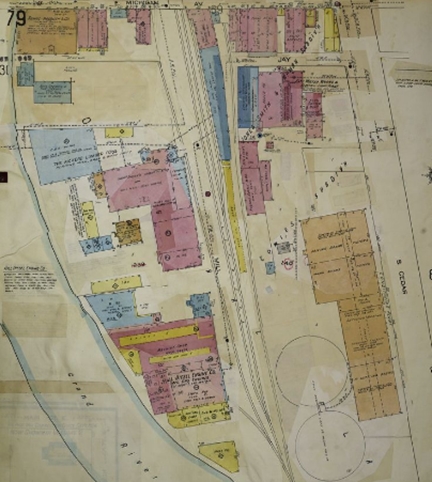
This view of the Sanborn fire map from 1951
shows Hill Diesel in the lower left hand corner. To the east is
the Lansing Board of Water and Light's water treatment plant. Note
the two circular tanks at the bottom of the photo. With Cedar
Street on the east side of the map and Michigan Avenue to the north, I
recognized this as being the current home of the R.E. Olds Museum.
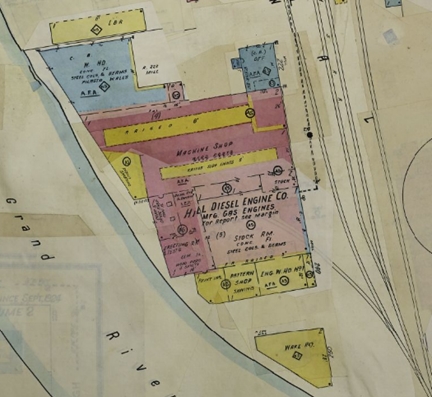
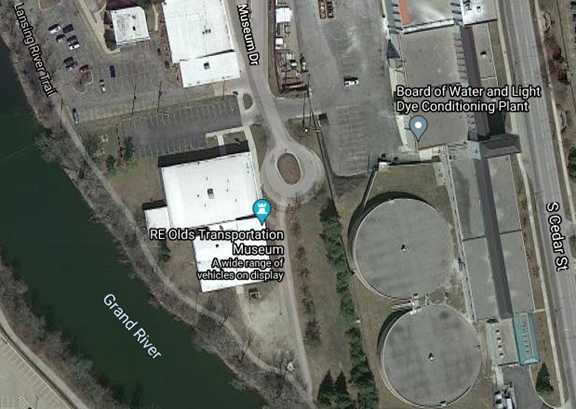
The Google Maps satellite view shows the
current R.E. Olds Museum with the circular tanks to the east of it.
The railroad tracks are long gone. Sections of the former Hill
Diesel plant have been removed, but the current building has most of the
structure from the 1951 Sanborn map.
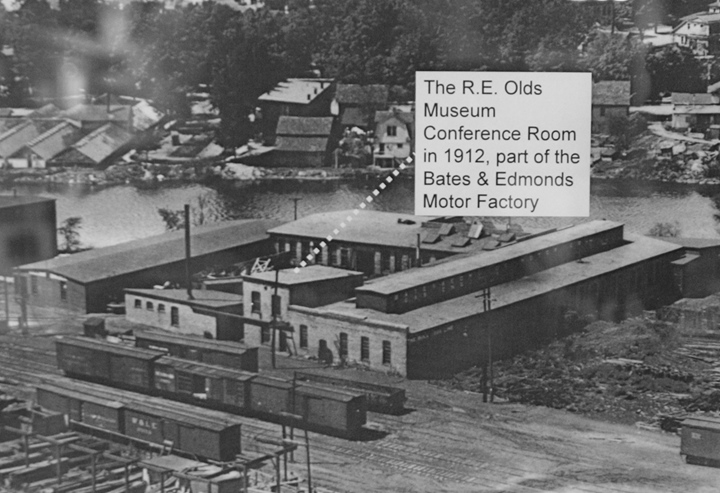
The Hill Diesel Company originally started
in 1899 as the Bates & Edmonds Motor Factory. Mr. Bates and
Edmonds were former employees of R.E. Olds who started their own engine
company. The two story building identified as the current
conference room and the building next to it still exist. The empty
courtyard in the center of the complex was later made into factory
space. There were a number of railroad tracks in front of the
factory in 1912. Of interest are all of the buildings on the
opposite side of the Grand River at the time. Those are all long
gone. Author's photo of an R.E. Olds Transportation Museum photo.
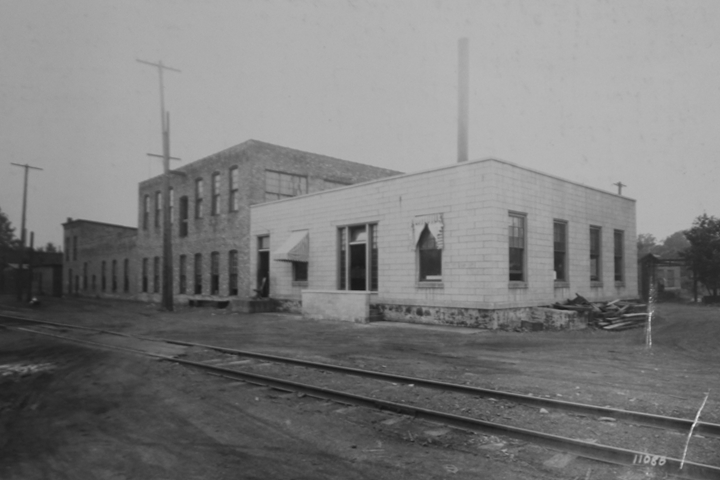
This undated photo is from a later time
period. The large two story building and the square building in
the foreground have been added. The square building is now gone.
Currently, the museum is all one story with the exception of the
conference room building. Author's photo of an R.E. Olds
Transportation Museum photo.
Hill Diesel Company Word War Two Production: Table 1 shows
that Hill Diesel had $16,143,000 in major contracts during World War
Two. Table 1 also shows the majority of the company's contracts
were for generator sets, diesel engines, and parts to the U.S. Army and
U.S. Navy. However, the first three contracts in early 1942 were
from the Treasury Department for pumps. While Table 1 does not
specify the particular types of generators it produced, Hill Diesel has
been identified as building an unknown number of PE-85-L, PE-205-A, and
PE-207-A generators for the U.S. Army Signal Corps during World War Two.
These generators were used for fixed base
operation of radio communication equipment.
Table 1 - Hill Diesel Company's
Major World War Two Contracts
The information below
comes from the "Alphabetical Listing of Major War Supply
Contracts, June 1940 through September 1945." This was
published by the Civilian Production Administration, Industrial
Statistics Division. Table added 4-2-2022. |
|
Product - Customer |
Contract Amount |
Contract Awarded
|
Completion
Date |
| Pumping Equipment
- Treasury |
$73,000 |
2-1942 |
9-1943 |
| Pump -
Treasury |
$147,000 |
3-1942 |
9-1943 |
| Pump Units -
Treasury |
$112,000 |
3-1942 |
9-1943 |
| Generator Sets -
Navy |
$4,462,000 |
4-1942 |
12-1943 |
| Generating Sets -
Treasury |
$110,000 |
4-1942 |
9-1943 |
| Electrical
Equipment |
$57,000 |
4-1942 |
9-1943 |
| Power Units -
Army |
$4,968,000 |
8-1942 |
12-1943 |
| Generator Sets -
Navy |
$136,000 |
12-1942 |
6-1943 |
| Generator Sets -
Navy |
$1,261,000 |
12-1942 |
4-1944 |
| Diesel Power
Units - Army |
$74,000 |
6-1943 |
12-1943 |
| Diesel Engine
Parts - Navy |
$84,000 |
6-1943 |
2-1944 |
| Diesel Generator
Sets - Navy |
$288,000 |
6-1943 |
1-1944 |
| Diesel Engine
Parts - Army |
$330,000 |
7-1943 |
7-1944 |
| Diesel Engine
Parts - Navy |
$162,000 |
10-1943 |
11-1943 |
| Diesel Engines -
Army |
$258,000 |
10-1943 |
4-1944 |
| Diesel Generator
Sets - Navy |
$136,000 |
11-1943 |
3-1944 |
| Diesel Generator
Sets - Navy |
$287,000 |
11-1943 |
7-1944 |
| Diesel Engines -
Army |
$58,000 |
11-1943 |
5-1944 |
| Diesel Engines -
Army |
$733,000 |
11-1943 |
10-1944 |
| Diesel Engines -
Army |
$260,000 |
11-1943 |
10-1944 |
| Diesel Engines -
Army |
$107,000 |
11-1943 |
10-1944 |
| Diesel Engines -
Army |
$566,000 |
11-1943 |
6-1944 |
|
Electrical Generator Sets - Army |
$104,000 |
1-1944 |
7-1944 |
| Adaptors Grommets
- Army |
$68,000 |
2-1944 |
3-1944 |
| Diesel Engine
Parts - Navy |
$639,000 |
3-1944 |
3-1945 |
| Diesel Engine
Parts - Navy |
$50,000 |
3-1944 |
5-1944 |
| Diesel Engine
Parts - Navy |
$62,000 |
5-1944 |
7-1944 |
| Diesel Generator
Sets - Navy |
$102,000 |
7-1944 |
1-1945 |
| Diesel Generator
Sets - Navy |
$87,000 |
7-1944 |
2-1945 |
| Power Unit Parts-
Army |
$133,000 |
10-1944 |
12-1944 |
| Diesel Generator
Sets - Navy |
$51,000 |
2-1945 |
8-1945 |
| Electrical
Equipment - Navy |
$119,000 |
3-1945 |
7-1945 |
| Electrical
Equipment - Navy |
$59,000 |
3-1945 |
8-1945 |
| Total |
$16,143,000 |
|
|
After World War Two, the number of employees
was normally 70 people. However, during World War Two the company
employed 550. Production was conducted in two other plants besides
the one at 238 Mill Street.
Hill Diesel began marketing 2R, 4R, and 6R in 1940. These were the
engines it supplied during the war to power electric generators.
The number in front of the R designates the number of cylinders.
The cylinders on the R series engines had a stroke of 5.5 inches and a
bore of 3.5 inches. The 4R engine produced 34 hp at 1,200rpm and
the 6R produced 44hp at 1,200 rpms.
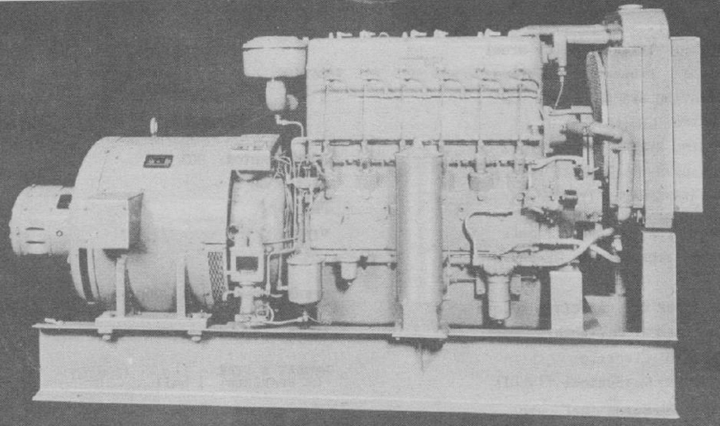
The Signal Corps PE-85-L utilized a Hill 6R
engine and a Rogers Diesel and Aircraft Model S110 230 VAC 75 KW
generator.
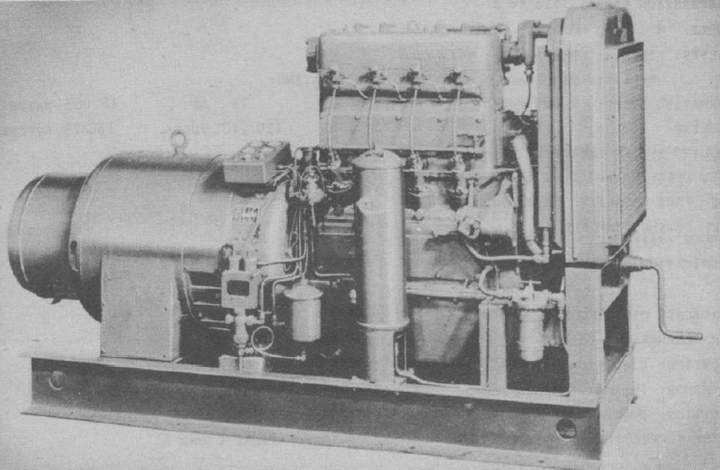
The Signal Corps PE-205-A utilized the Hill
4R and a GE Model 21G342 230/240 VAC 13 KW generator.
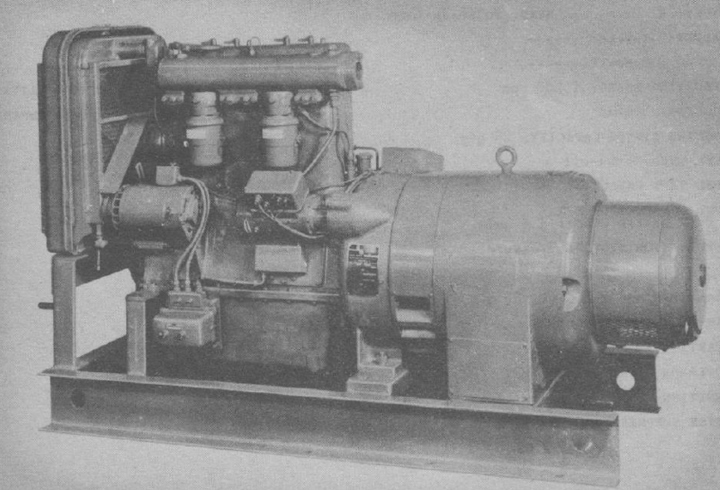
The Signal Corps PE-207-A utilized a Hill 4R
engine and a GE 12G342 120/208 VAC 15 KW generator.
The former Hill Diesel Factory now as the
R.E. Olds Transportation Museum: The Drake Corporation closed
Hill Diesel in 1952. The equipment and spare parts were auctioned
off and the company faded into the past. The reason I was totally
unaware of Hill Diesel until July 2021 is that I was not yet old enough
for kindergarten when it closed. In 1977 the R.E. Olds
Transportation Museum was formed and in 1981 it opened its doors in the
former Hill Diesel Company factory. Below are a series of photos
of the current exterior and interior of the building.
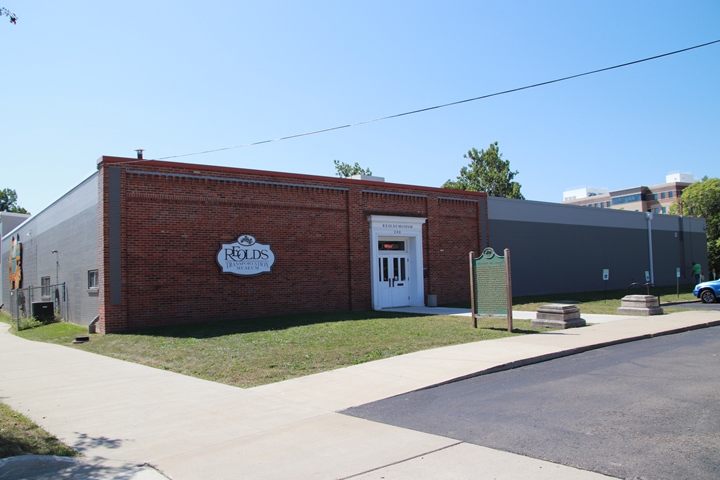
This photo shows the north-side entrance to
the R.E. Olds Transportation Museum at 240 Museum Drive in Lansing, MI.
The museum has added a section of new red brick to the entrance area of
the building. The rest of the building is constructed of either
blocks or original brick. These blocks and bricks have been
painted gray. Author's photo.
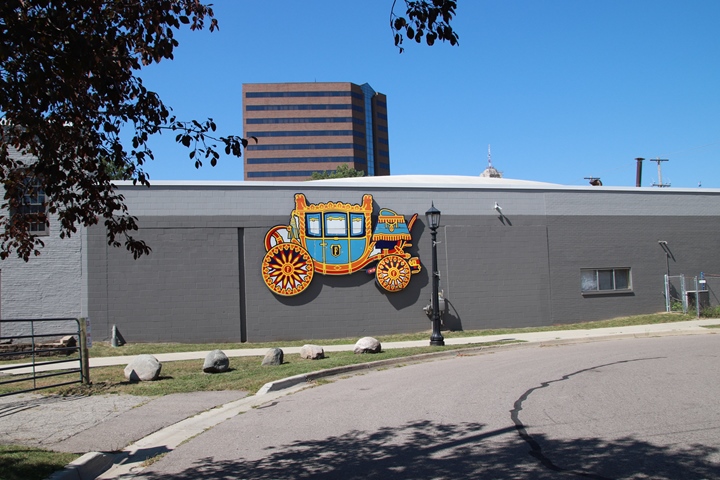
This photo of the north end of the east wall
has the "Body by Fisher" sign displayed that was on the east end of the
south wall of the former Fisher Body plant in Lansing. This sign
faced Michigan Avenue near the corner of Verlinden Avenue. It was
good to see this again. Author's photo.
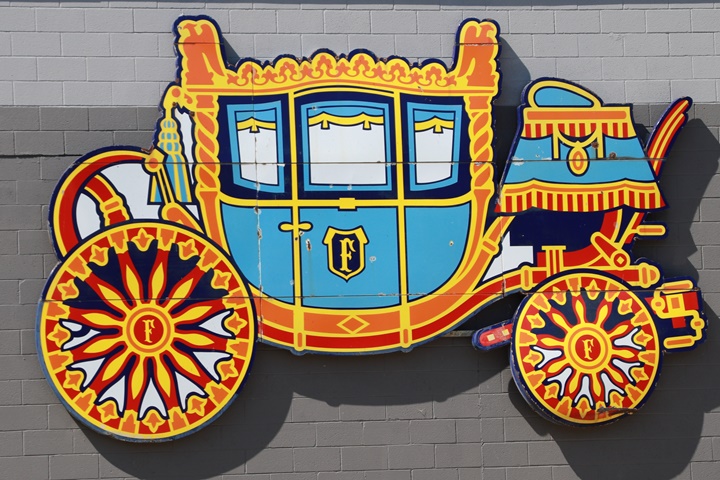
The sign is in excellent condition.
The Reo Museum is taking excellent care of this historic artifact.
It may be the only one left from all of the former Fisher Body plants.
Author's photo.
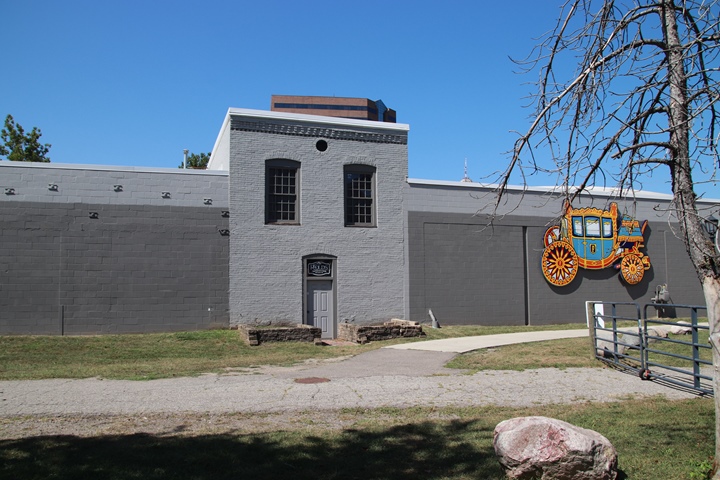
The R.E. Olds Transportation Museum board
room is inside the two story building. Author's photo.
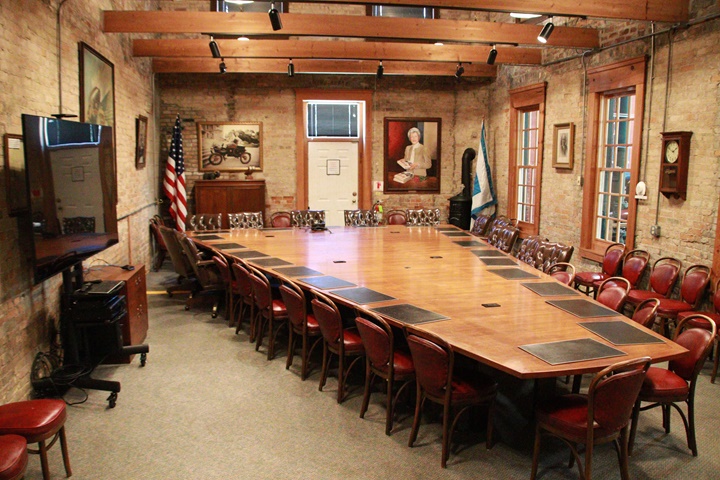
On my visit to the Olds Museum in September
2021, Mr. Rick Kaiser, Operations Manager of the Museum, allowed me in
to the museum's conference room. Wow!! How cool is this?
Now this is a conference room!! The windows on the right (south
side) of the room indicate that originally there was open space to the
south, which over the years became inside factory space. Author's
photo.
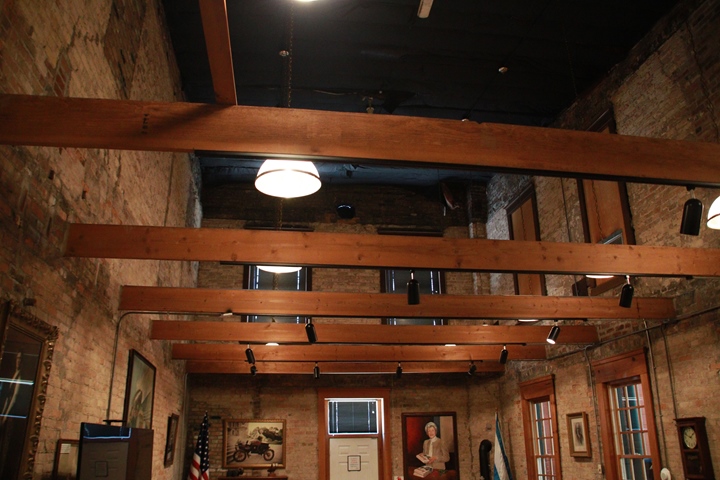
This may have been the original factory
building with a high bay ceiling. Author's photo.
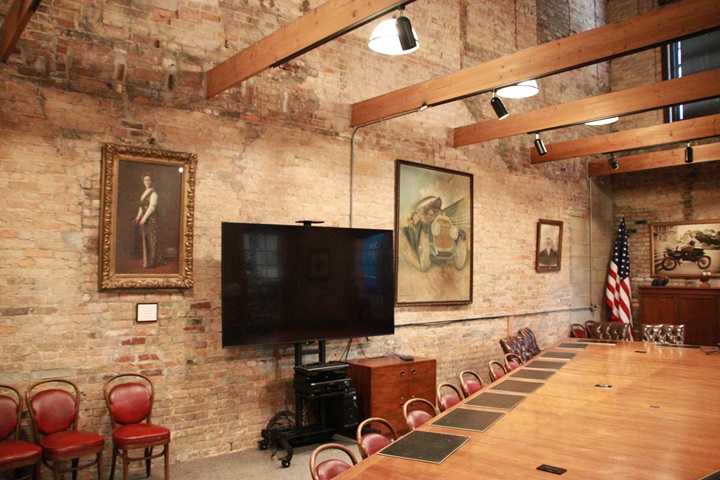
Although the original brick has been painted
over, some of the paint has come off, revealing the building was
constructed of red brick. Author's photo.
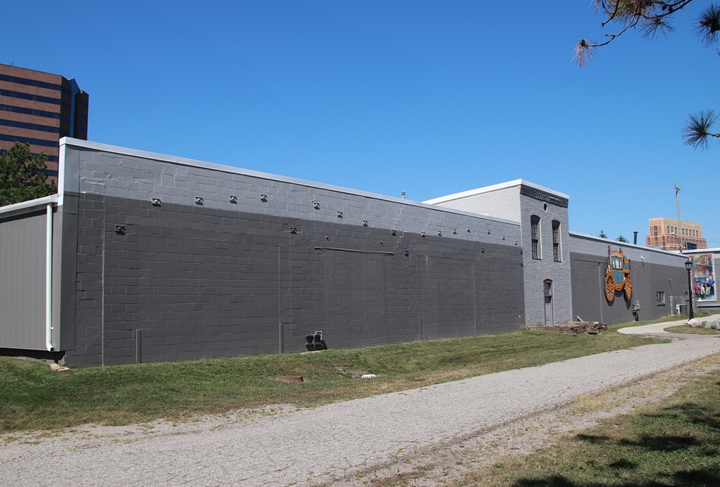
This view shows the entire east wall from
the south end of the building. Over the years several doors have
been blocked over. Author's photo.
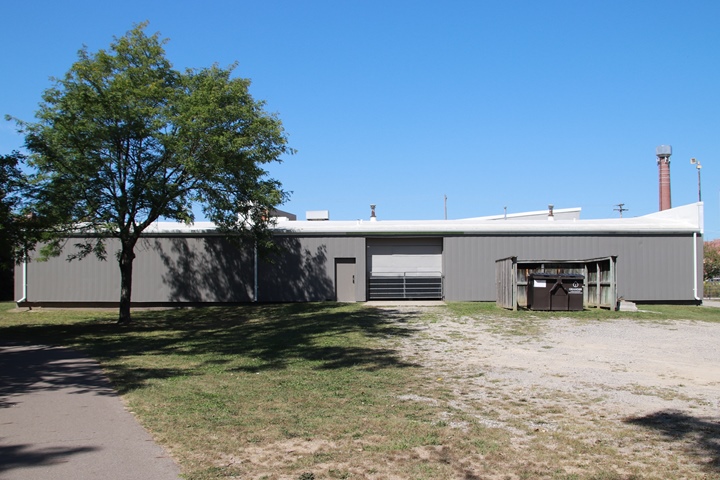
This photo shows the south side of the
building. Note the overhead door in the photo. It will be
shown in a later photo from the inside of the building. Author's
photo.
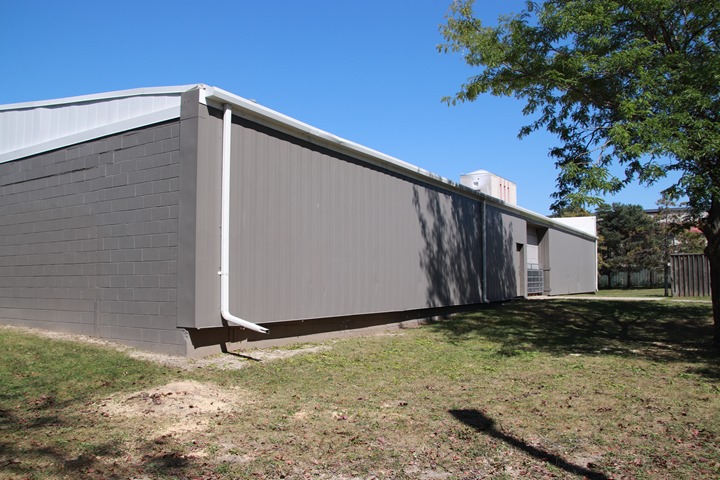
The south side of the building has had steel
panels installed on it. Author's photo.
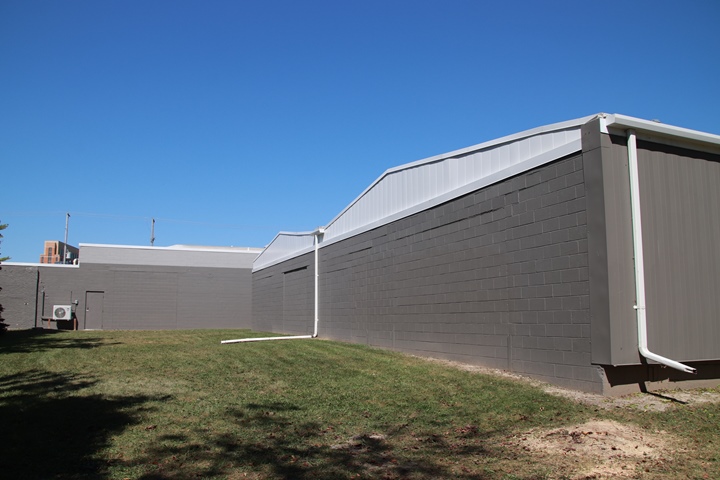
Author's photo.
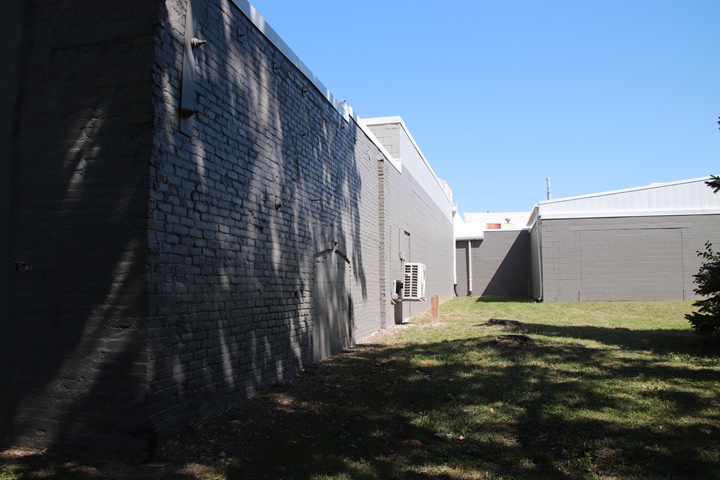
This corner section of the building was
constructed of brick. Author's photo.
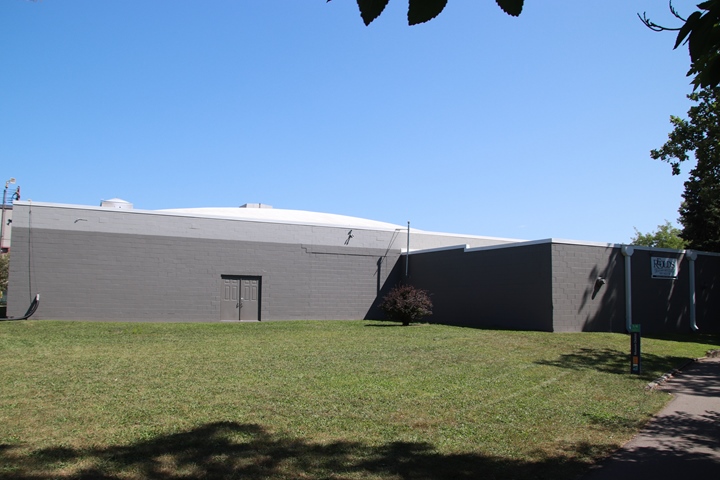
This is the north end of the west wall.
Author's photo.
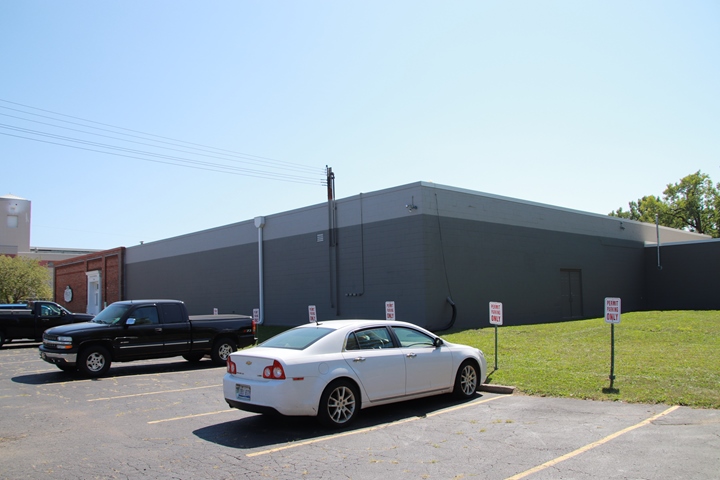
Considering the structure is over 100 years
old, it is in very good shape. The museum has done an excellent
job of maintaining it. Author's photo.
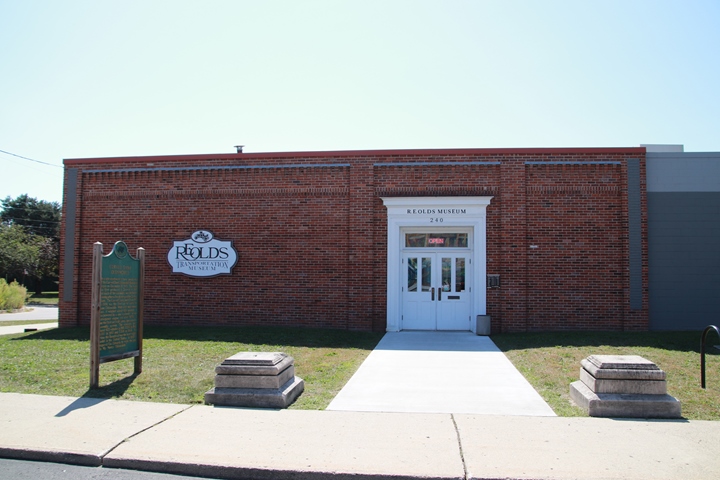
The Olds Museum has 65 vehicles built in
Lansing, in addition to displays on the history of several different
companies in Lansing. It is well worth the effort to visit it.
Author's photo.
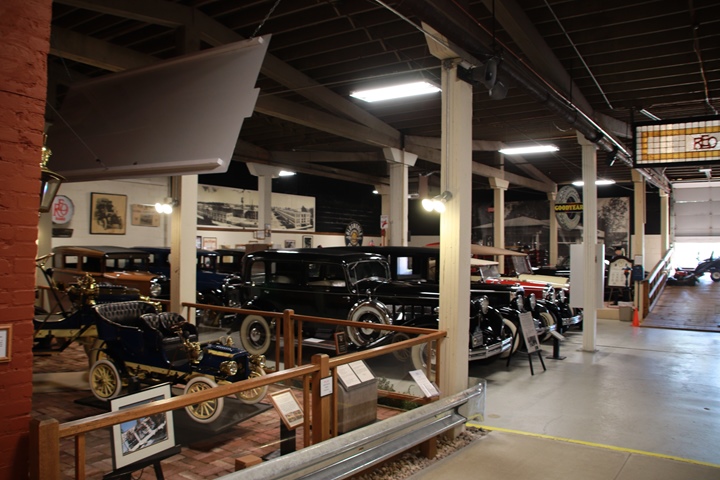
This is the south end of the building.
The red brick in the left hand section of the photo is the south side of
the conference room. Note that the original wooden beams still
hold up the roof. The south side of the building is lower than the
north side and there is a ramp that one walks down to view the cars at
the back of the museum. Author's photo.
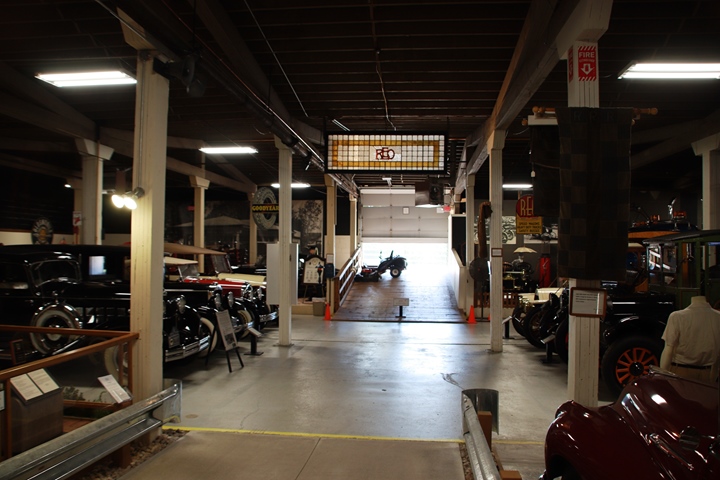
This shows the overhead door and the ramp
leading up to it from the inside. The south end of the building
displays non-Oldsmobile cars and trucks. This includes Reo, Starr,
and Diamond Reo vehicles. It also has several non-vehicle displays
for such companies as Motor Wheel. Author's photo.
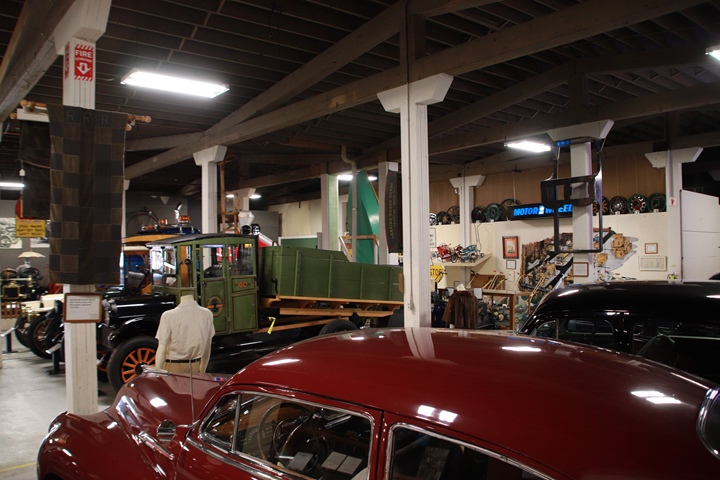
The green dump truck is a 1925 Reo Speedwagon which is in pristine
condition. In the Motor Wheel display on the right wall are many
of the lawnmowers built by Reo and Motor Wheel. Motor Wheel bought
the business from Reo in 1954 and then sold it to Wheelhorse in 1963.
Author's photo.
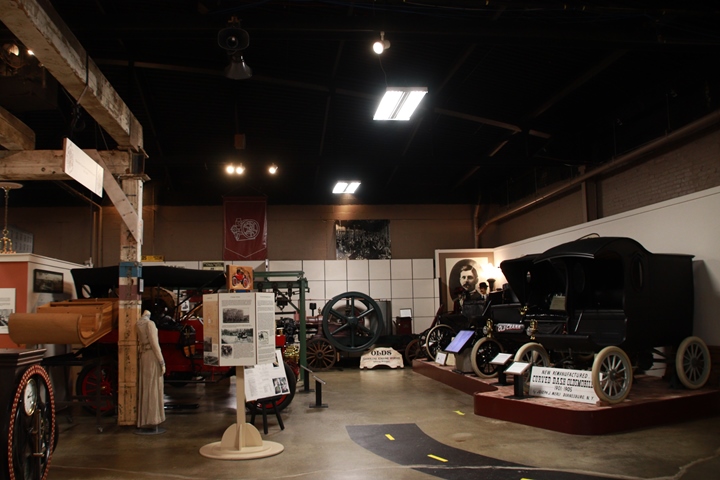
The north end of the museum has a section of
early vehicles and engines made in Lansing. Author's photo.

The firewall that separates the north and
south sides of the building is on the left side of the photo.
There are lots of classic Oldsmobiles in this section. Author's
photo.
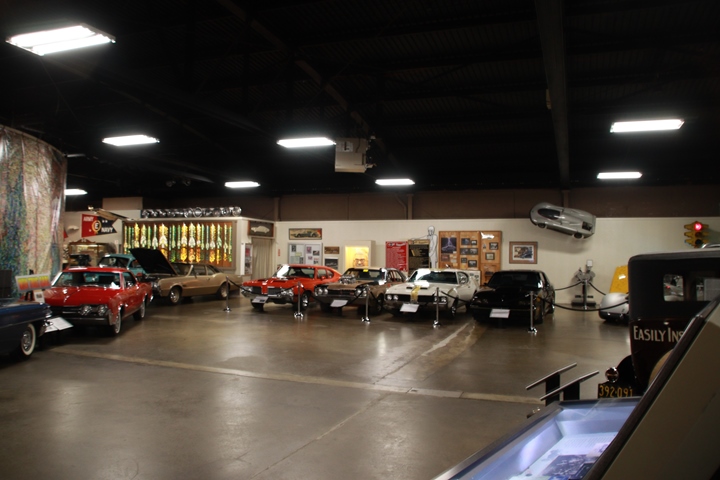
This section of the museum has a self
supporting roof. The Oldsmobile Army-Navy "E" flag is on display in
the corner. Author's photo.
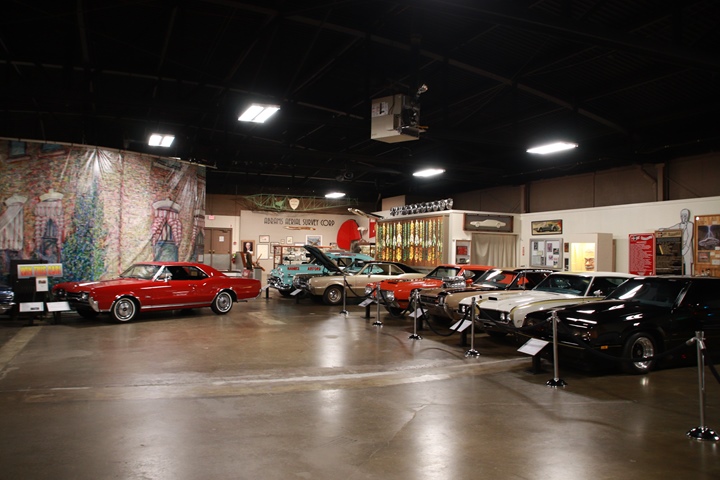
Also in the corner are several displays on
World War Two products from Lansing and an Abrams Aerial Survey
Corporation display. Author's photo.
Other Lansing Companies that contributed
to winning World War Two
|





























